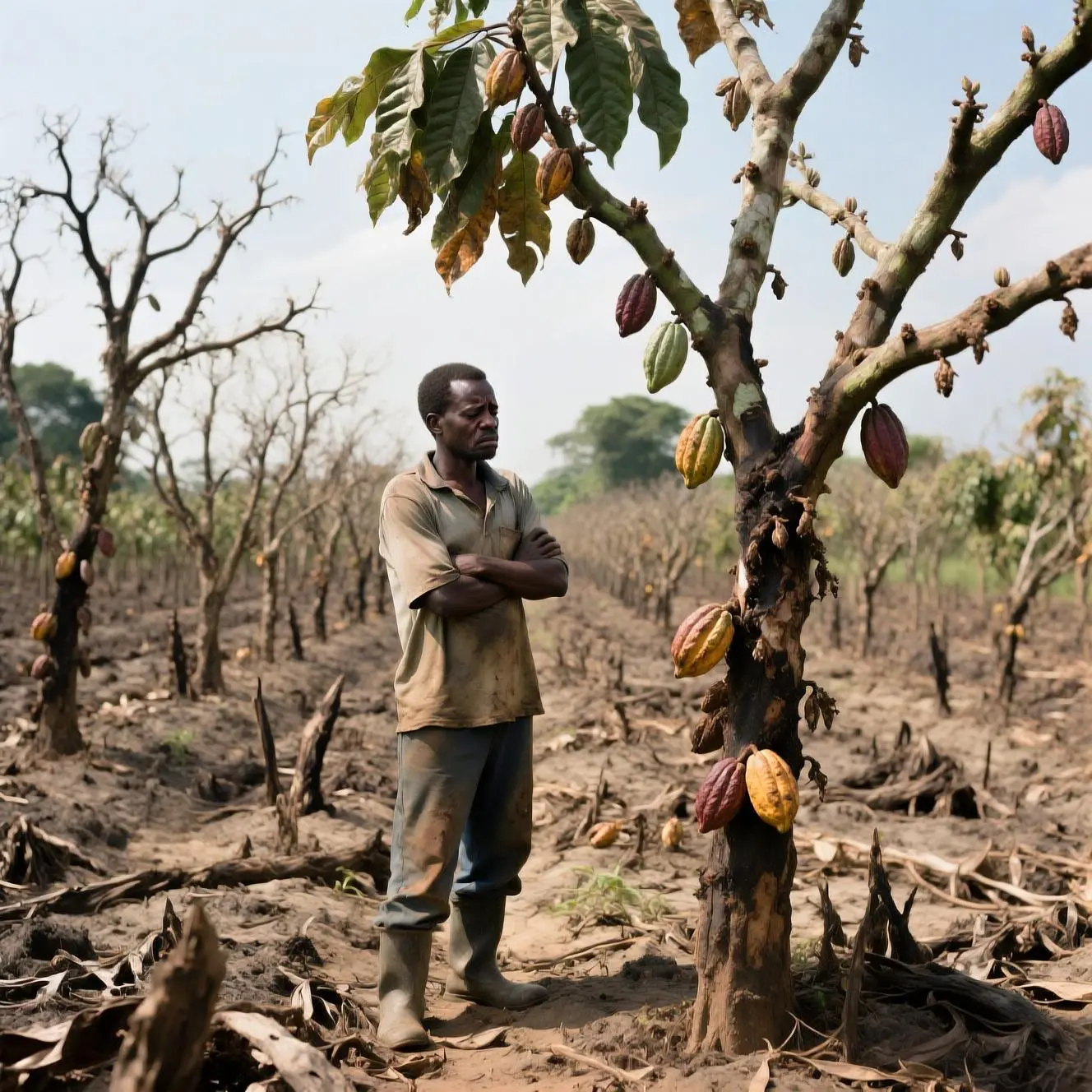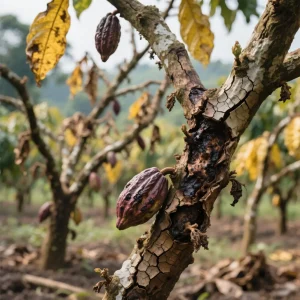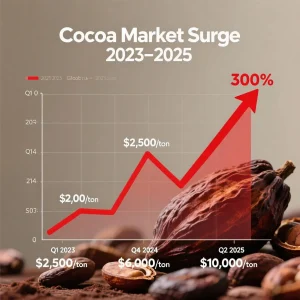
Cocoa Prices Surge Over 300% as Virus Decimates Ghana’s Harvest: A Bitter Pill for the Global Chocolate Industry
The global cocoa market is in turmoil. An unprecedented surge of over 300% in cocoa prices has sent shockwaves through the supply chain, with the cost of this essential chocolate ingredient reaching historic highs. At the heart of this crisis lies a perfect storm of climate change, aging plantations, and, most critically, the rampant spread of the Cacao Swollen Shoot Virus Disease (CSSVD) in West Africa, particularly Ghana. This devastating virus is crippling the output of the world’s second-largest cocoa producer, creating a severe supply deficit that is reshaping the future of chocolate for everyone from multinational corporations to artisanal chocolatiers.
For consumers, this means the era of affordable chocolate may be coming to an end. For investors and industry stakeholders, this volatility presents both significant risks and unique opportunities. This in-depth analysis will dissect the multifaceted causes behind the price explosion, explore the profound impact of the CSSVD, and provide an expert outlook for the future of cocoa and the chocolate industry in 2025 and beyond.
The Anatomy of a Crisis: Why Are Cocoa Prices Skyrocketing?(Cocoa Prices Surge)
The current spike in cocoa prices is not a singular event but the culmination of several persistent and interconnected factors. While media headlines have focused on the dramatic price charts, understanding the root causes is crucial for navigating the market’s future. The primary drivers include severe weather patterns, systemic agricultural challenges, and the devastating impact of crop disease.
Adverse weather, exacerbated by the El Niño phenomenon and broader climate change, has led to unusually heavy rainfall followed by severe drought in both Ghana and neighbouring Ivory Coast, which together supply over 60% of the world’s cocoa. These extreme conditions have damaged crops and fostered the spread of diseases like black pod rot.
Furthermore, many of the region’s cocoa farms are decades old, with aging trees that are well past their peak productivity. A lack of investment in modern farming techniques and rehabilitation of these “cacaoyères” has created a structural weakness in the supply chain, making it highly vulnerable to shocks.
However, the most acute and destructive factor has been the Cacao Swollen Shoot Virus Disease (CSSVD). According to reports from the Ghana Cocoa Board (Cocobod), the virus has infected vast swathes of farmland. A 2024 report highlighted that over 500,000 hectares of cocoa farms in Ghana were infected. This plant pandemic is the principal catalyst for the current supply collapse.
A Viral Menace: Understanding the Cacao Swollen Shoot Virus (CSSVD)(Cocoa Prices Surge)
The Cacao Swollen Shoot Virus is not a new problem, but its recent resurgence has been catastrophic. First discovered in Ghana in the 1930s, the virus is spread by mealybugs that feed on the sap of cocoa trees. There is no cure for CSSVD; once a tree is infected, it’s a death sentence.
The Devastating Impact on Cocoa Trees
- Initial Symptoms: The first signs of infection are often subtle, including red vein-banding on young leaves.
- Progression: As the disease progresses, it causes the titular “swollen shoots” and stems.
- Yield Collapse: Within the first year of infection, a tree’s cocoa pod yield can drop by 25%. By the second year, this can reach 50%.
- Eventual Death: Most infected trees die within 2 to 3 years, leaving farmers with barren land.
The only effective method of controlling the spread of CSSVD is to cut down and burn the infected trees—a costly and labour-intensive process that Ghanaian farmers are often reluctant to undertake without significant financial support. The Ghana Cocoa Board, with assistance from the World Bank, has implemented rehabilitation programs, but the scale of the outbreak has overwhelmed these efforts, creating a massive shortfall in cocoa bean production.
also read:UAE Residency Visa Renewal Process

Ripple Effects: From the Farmer to the Consumer
The consequences of this supply crisis are far-reaching, impacting every level of the global chocolate industry. The surge in raw material costs is creating a bitter reality for manufacturers and chocolate lovers alike.
Price Comparison of Cocoa Over Time
| Period | Average Price per Metric Ton (USD) | Key Market Factors |
| 2022-2023 | ~$2,500 | Stable weather, balanced supply/demand |
| Early 2024 | ~$4,200 | Initial reports of poor harvests, weather concerns |
| Late 2024 | ~$10,000 | Severe supply deficit confirmed, disease impact priced in |
| Mid-2025 | ~$8,500 – $9,500 (Volatile) | Market reacting to 2024/25 crop forecasts, continued uncertainty |
This dramatic cost increase is forcing major chocolate manufacturers like Nestlé, Mars, and Hershey’s to make difficult decisions. Consumers are already seeing the results on store shelves:
- Shrinkflation: Chocolate bars are getting smaller while their prices remain the same or increase.
- Retail Price Hikes: The cost of premium and mass-market chocolate products has risen significantly.
- Ingredient Changes: Some manufacturers may alter their recipes to use less cocoa, potentially affecting the taste and quality of beloved brands.
For the millions of smallholder farmers in Ghana, the situation is a double-edged sword. While higher global prices should theoretically mean more income, the reality is that many have lost their entire livelihoods to the virus and are unable to produce any beans to sell.

Market Outlook for 2025 and Beyond: A Call to Action
While cocoa prices have shown some volatility in mid-2025 after peaking, experts do not anticipate a return to pre-crisis levels anytime soon. The World Bank forecasts that while production may slightly recover in the 2024/2025 season, the market will remain incredibly tight. The structural issues of disease and aging trees will take years to resolve.
This crisis serves as a critical wake-up call for the entire industry. To secure the future of chocolate, a concerted and sustainable approach is required.
Actionable Steps for Stakeholders:
- Investment in R&D: The development of CSSVD-resistant cocoa varieties is paramount. Collaborative efforts between governments, research institutions like the Cocoa Research Institute of Ghana (CRIG), and private companies are essential.
- Sustainable Farming Practices: Increased investment in farmer training, rehabilitation of old farms, and diversification of farmer income is needed to build a more resilient supply chain.
- Supply Chain Transparency: For commercial buyers, now is the time to invest in direct sourcing and partnerships with cocoa cooperatives. This ensures a more stable supply and supports farmers who are committed to sustainable practices.
- Portfolio Diversification: For investors, the volatility in the cocoa market highlights the risks of commodity concentration. Exploring agricultural technology and companies focused on sustainable solutions could offer long-term growth potential.
Your business needs to adapt to this new reality. Whether you are a food manufacturer, a commodity trader, or an investor, understanding the nuances of this crisis is key to making informed decisions.
also read:Cost of Living in Dubai vs Abu Dhabi 2025: Real Comparison
Frequently Asked Questions (FAQ)
What is the main reason for the 300% surge in cocoa prices?
The primary driver is a severe global supply shortage caused by a combination of factors in West Africa, the world’s main cocoa-growing region. The most significant factor is the outbreak of the Cacao Swollen Shoot Virus Disease (CSSVD) in Ghana and Ivory Coast, which has decimated crops. This is compounded by adverse weather conditions linked to climate change and systemic issues like aging cocoa trees.
Will chocolate prices go down in 2025?
While market prices for cocoa have shown some volatility and have slightly decreased from their absolute peaks in late 2024, experts do not expect a significant drop in consumer chocolate prices in 2025. The global supply deficit is expected to persist, keeping raw material costs high for manufacturers. Any price relief is likely to be modest and slow to reach the retail level.
What is being done to fight the Cacao Swollen Shoot Virus (CSSVD)?
The main strategy to combat CSSVD is the physical removal of infected trees to prevent further spread. The Ghana Cocoa Board (Cocobod), with support from international bodies like the World Bank, is running programs to help farmers cut down diseased trees and replant with new, hopefully more resistant, varieties. There is also ongoing research to develop cocoa strains that are tolerant or resistant to the virus.
How can businesses protect themselves from cocoa price volatility?
Businesses that rely on cocoa can explore several strategies. These include long-term contracting with suppliers, investing in supply chain sustainability and transparency to secure future access, diversifying their product lines to reduce reliance on cocoa-heavy items, and engaging in careful commodity hedging. For a detailed analysis, businesses should consult with market experts and consider tailored risk management strategies.
What is the main reason for the 300% surge in cocoa prices?
The primary driver is a severe global supply shortage caused by a combination of factors in West Africa, the world’s main cocoa-growing region. The most significant factor is the outbreak of the Cacao Swollen Shoot Virus Disease (CSSVD) in Ghana and Ivory Coast, which has decimated crops. This is compounded by adverse weather conditions linked to climate change and systemic issues like aging cocoa trees.
Will chocolate prices go down in 2025?
While market prices for cocoa have shown some volatility and have slightly decreased from their absolute peaks in late 2024, experts do not expect a significant drop in consumer chocolate prices in 2025. The global supply deficit is expected to persist, keeping raw material costs high for manufacturers. Any price relief is likely to be modest and slow to reach the retail level.
What is being done to fight the Cacao Swollen Shoot Virus (CSSVD)?
The main strategy to combat CSSVD is the physical removal of infected trees to prevent further spread. The Ghana Cocoa Board (Cocobod), with support from international bodies like the World Bank, is running programs to help farmers cut down diseased trees and replant with new, hopefully more resistant, varieties. There is also ongoing research to develop cocoa strains that are tolerant or resistant to the virus.
How can businesses protect themselves from cocoa price volatility?
Businesses that rely on cocoa can explore several strategies. These include long-term contracting with suppliers, investing in supply chain sustainability and transparency to secure future access, diversifying their product lines to reduce reliance on cocoa-heavy items, and engaging in careful commodity hedging. For a detailed analysis, businesses should consult with market experts and consider tailored risk management strategies.
sources:
– Bloomberg
– The Wall Street Journal
– Financial Times– Ghana Cocoa Board









1 thought on “Cocoa Prices Surge 300% in 2025 as Ghana Battles Crop Virus Crisis”